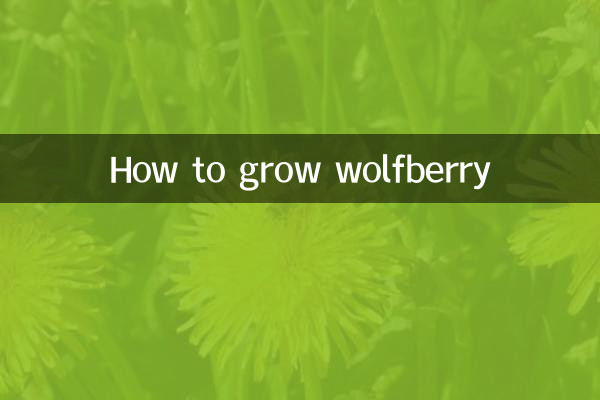How to grow wolfberry
In recent years, with the craze for health and wellness, wolfberry has attracted much attention as a plant with the same origin as medicine and food. Many farmers and home growers have begun trying to grow wolfberries to gain access to their rich nutritional value and economic benefits. This article will introduce the planting method of wolfberry in detail, including key aspects such as seed selection, seedling cultivation, field management, pest and disease control, etc., and provide structured data for reference.
1. Basic conditions for wolfberry planting

Wolfberry is highly adaptable, but you still need to pay attention to the following conditions when planting:
| condition | Specific requirements |
|---|---|
| climate | It likes warmth and is cold-tolerant. The suitable growth temperature is 15-25℃. |
| soil | Loose, well-drained sandy loam soil is preferred, with a pH value of 6.5-8.5 |
| illumination | Requires sufficient sunlight, no less than 6 hours a day |
| Moisture | Tolerant to drought but not waterlogging, the soil needs to be kept moist during the growing period |
2. Steps of planting wolfberry
1. Seed selection and seedling cultivation
Choosing high-quality wolfberry seeds or cuttings is the first step to successful planting. Common wolfberry varieties include Ningxia wolfberry, black wolfberry, etc. Suitable varieties can be selected according to the local climate.
| Seedling raising method | How to operate | time |
|---|---|---|
| Seed seedlings | Soak the seeds for 24 hours before sowing and cover with 1cm of soil. | Spring March-April |
| Cutting seedlings | Select strong branches, cut them into 15cm cuttings, and insert them into the seedbed. | spring or autumn |
2. Field planting
Planting can be carried out when the seedling height reaches 20-30cm. Before planting, it is necessary to prepare the land and apply fertilizer, and apply 2000-3000kg of decomposed organic fertilizer per acre.
| project | Specification requirements |
|---|---|
| line spacing | 2-2.5 meters |
| spacing between plants | 1-1.5 meters |
| Depth of planting | 15-20cm |
3. Field management
During the growth period of wolfberry, the following management tasks need to be done:
| Manage projects | Operational points | time |
|---|---|---|
| irrigation | Keep the soil moist and control water appropriately during flowering period | growth period |
| fertilize | Topdress 3-4 times a year, mainly nitrogen, phosphorus and potassium compound fertilizers | growing season |
| prune | Spring pruning to remove diseased and weak branches | March-April |
4. Pest and disease control
Common wolfberry pests and diseases and their prevention and control methods:
| pests and diseases | symptom | Prevention and control methods |
|---|---|---|
| powdery mildew | White powder appears on the leaves | Spray sulfur suspending agent |
| aphid | The leaves are curled and have black worm bodies | Spray imidacloprid |
| Wolfberry gall mite | Yellow spots appear on leaves | Spray abamectin |
3. Harvesting and processing
Wolfberry fruits generally mature from June to October, and the harvest standard is that the fruits turn red and plump. After harvesting, they should be sun-dried or dried promptly.
| Processing method | Operational points | Things to note |
|---|---|---|
| dry | Spread out in a ventilated place to dry | Avoid exposure to the sun |
| drying | The temperature is controlled at 45-50℃ | Prevent excessive temperature |
4. Economic benefit analysis
The economic benefits of wolfberry planting are considerable. Generally, it enters the peak yield period in three years and can be harvested continuously for more than 10 years. Here are the main economic indicators:
| project | data |
|---|---|
| Yield per mu | 200-300kg (dried fruit) |
| market price | 30-80 yuan/kg (depending on quality) |
| input cost | 3000-5000 yuan/mu/year |
| net profit | 5,000-15,000 yuan/mu/year |
5. Precautions for planting
1. Choose varieties suitable for your local climate
2. Pay attention to drainage and waterlogging prevention
3. Plant reasonably densely to ensure ventilation and light transmission
4. Process in time after harvest to avoid mildew.
5. Establish a complete pest and disease monitoring system
Conclusion
Wolfberry cultivation is a long-term investment that requires growers to master scientific management techniques. Through reasonable variety selection, standardized field management and scientific processing methods, stable economic benefits can be obtained. As people's demand for healthy food increases, wolfberry cultivation has broad prospects and is worthy of farmers' attention and attempts.

check the details

check the details